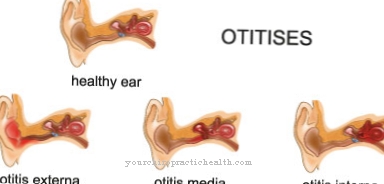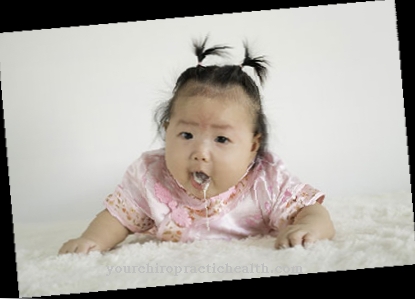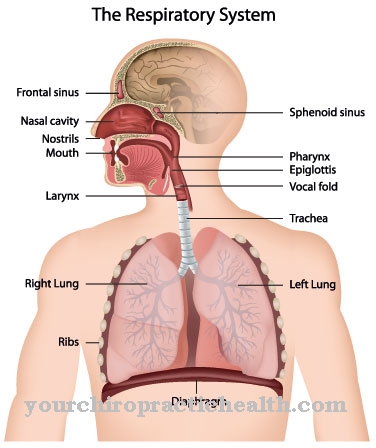The Kabuki syndrome, also as Kabuki makeup syndrome or Niikawa-Kuroki syndrome known, is a very rare hereditary disease. The cause is so far unknown; the therapy is concerned with relieving symptoms. So far there is neither extensive information about the symptoms nor about the course of the disease; the syndrome cannot be prevented.
What is Kabuki Syndrome?

© lucadp - stock.adobe.com
Dr. Kuroki and Dr. Niikawa described the syndrome - independently - for the first time in 1980. Kabuki syndrome is a relatively "new" disease; for this reason, very little is known about the syndrome. The term kabuki make-up syndrome describes the characteristics of the disease. In the end, those affected remember the kabuki performers in Japanese theaters.
Due to the fact that the term “make-up” had a negative association with it, medical professionals mainly use the term Kabuki syndrome. Due to the fact that very few medical professionals are actual professionals in the field of the disease, the syndrome has rarely been diagnosed. However, one has to assume that - at most - several hundred people (worldwide) are affected by Kabuki syndrome. How high the real figure is cannot be said.
causes
So far, the reason why the Kabuki syndrome can break out is unknown. Doctors assume a sporadic or spontaneous mutation in the genetic structure. So far, researchers have been able to rule out external circumstances or certain environmental conditions that trigger the genetic error.
In a few cases, children whose parents (or one of the parents) also carried the same mutation and were thus affected by Kabuki syndrome were affected. So far, however, there have been very few people whose parents (or at least one parent) were also affected by Kabuki syndrome. Also because the course of the disease is different and in many cases those affected cannot lead a regular life - in the sense of starting a family.
However, from the documented cases it must be concluded that Kabuki syndrome is an autosomal dominant hereditary disease. The risk that the genetic defect will be passed on is therefore 50/50.
Symptoms, ailments & signs
The syndrome has a very diverse and broad spectrum. Those affected suffer from arched and wide eyebrows, elongated eyelids and a flat nose tip and large, protruding and cup-shaped ears. Many sufferers have a high palate, a cleft lip and palate or even tooth anomalies. However, while the children are of normal size at birth, growth will be retarded over time.
While at the beginning of the research it could still be assumed that microcephaly was one of the characteristic symptoms, more and more cases were known that were not affected by it. Often there are anomalies of the skeletal system (brachymesophalangia, brachydactyly V as well as clinodactyly of the fifth fingers, dislocated or overstretchable joints and anomalies of the spine) as well as dermatoglyphic anomalies of the fetal fingertip pads.
In almost all cases there is an intellectual deficit of those affected; Sometimes patients also complain of neurological symptoms and sometimes suffer from seizures or hypotonia. The development of those affected is usually delayed. Sometimes autistic features, hearing loss and hyperactivity were also documented.
In a few cases, the sclera of those affected are bluish, which is reminiscent of the hereditary disease osteogenesis imperfecta (glass bone disease). Congenital heart defects, septal defects or left-sided obstructive lesions are also possible. Any malformations of the urinary tract and kidneys can also occur, with only 25 percent of those affected suffering from these symptoms and signs.
Diagnosis & course of disease
So far, no tests are available so that Kabuki syndrome can be diagnosed easily and safely. The geneticists therefore have to concentrate primarily on the specific traits. The diagnosis can therefore only be confirmed when the affected child has four of the five main characteristic features: skeletal abnormalities, characteristic facia, mental retardation, dermatoglyphic abnormalities or postnatal short stature.
Furthermore, the doctor must also carefully examine the characteristics of the face. The disease courses of Kabuki syndrome are different. So far, there is only a small amount of documentation, so it cannot be precisely explained how the Kabuki syndrome behaves. Furthermore, there are various forms of the syndrome.
While some children are able to lead a reasonably normal life, there are severe forms, so that those affected have to live with enormous restrictions (problems walking, standing, (speaking)). It is not known whether the kabuki syndrome has an impact on the life expectancy of those affected , but cannot be ruled out entirely.
Complications
Kabuki syndrome is one of the less common hereditary diseases. The Kabuki syndrome manifests itself in various congenital anomalies, especially in the face, as well as changes in the skeletal structure up to short stature and a partial intelligence disorder. The external abnormalities can already be recognized well in newborns, such as cleft lip and palate, sunken nose tip, protruding ears and overlong eyelid clefts to arched eyebrows.
Complications related to the syndrome increase with age. Due to their high susceptibility to infections, children with Kabuki syndrome are ailing and repeatedly suffer from colds and otitis media. Physical development is problematic, as those affected tend to develop scoliosis, hip dysplasias, tooth anomalies and overstretching of the finger joints. Obesity and massive cardiovascular problems often develop even before adolescence.
If Kabuki children learn therapeutic measures in the form of speech therapy, physiotherapy and occupational therapy as well as psychologically supervised development support at an early age, they can largely participate in school lessons. Intensive medical care allows further deficits to be identified, but only to a limited extent specifically treated.
The complexity of the disease and the complications that result from it are significant. Adolescent kabuki sufferers develop spontaneous seizures and neurological disorders, and the syndrome leads to hearing loss in almost every second person. The life expectancy of those with Kabuki syndrome is reduced.
When should you go to the doctor?
If the newborn has any malformations or abnormalities, a doctor should be informed. Kabuki syndrome can be recognized by its clear symptoms immediately after the child is born. Parents who notice cleft lip and palate, hearing problems, or stunted growth in their child are best advised to consult a doctor. Deafness, hyperactivity and seizures are also clear warning signs that require a doctor's examination. Close monitoring by the doctor is indicated during treatment.
Constant adjustment of the therapy is necessary, especially during the growth phase. Parents should tell the doctor about any unusual symptoms. If the child has cramps or pain, they should be taken to hospital. Kabuki syndrome is treated by the family doctor and various specialists, depending on the symptoms and complaints in question. Children should first be presented to a pediatrician. Obese sufferers should also consult a nutritionist. A comprehensive examination by the cardiologist is also required beforehand.
Therapy & Treatment
Due to the fact that no cause is known so far, Kabuki syndrome can only be treated symptomatically. This means that the doctors mainly assess the severity of the syndrome and then plan the treatment accordingly. If there are any restrictions on walking, standing or speaking, mainly physical and speech therapy units are recommended.
If, on the other hand, malformations of the organs have been diagnosed, the doctors concentrate primarily on the healing or treatment of the affected organs. For the medical profession, the preservation of life and the alleviation of symptoms and pain are in the foreground. Any physical pain that may occur as the disease progresses is treated with medication. Here, too, it is mainly only the symptoms, not the causes, that can be treated.
Outlook & forecast
The most effective self-help for Kabuki syndrome is sufficient and regular exercise. This does not mean a daily marathon or endurance sport in which you exhaust yourself. It is important to recognize your own limits and to have an experienced fitness trainer put together an individual training plan in cooperation with the treating doctor. This plan should then be regularly adapted to your own progress.
With daily exercise, the affected person can regain significantly more control over his muscles and counteract the muscle hypotonia that usually occurs or counteract this if treatment is started early. In addition, the movement stimulates the circulation and stimulates blood circulation, which supports the therapeutic effect.
In order to reduce the risk of injury in the event of seizures, care must be taken to ensure that the living area is designed to be fall-proof. Laying carpeting instead of tiled flooring can already reduce possible consequential injuries from a fall through the cushioned impact.
Last but not least, diet also plays a crucial role on the way to a better quality of life. A balanced magnesium balance lowers the intensity of cramps and this can not only be achieved with dietary supplements, but ideally with a consistent change in diet. Help is provided by trained nutritionists who take illnesses and allergies into account and put together the best individual diet.
prevention
As no cause is known so far, the Kabuki syndrome cannot be prevented. However, environmental influences, external causes or favorable factors can be completely excluded.
Aftercare
In the case of Kabuki syndrome, follow-up measures are in most cases very limited or not available to the person affected. Follow-up care is not always necessary for this disease, as the disease cannot be completely cured. Since this is a hereditary disease, a genetic examination and counseling should always be carried out first if the child wishes to have children so that the kabuki syndrome cannot recur in the descendants.
Early detection and treatment of the disease usually always has a positive effect on the further course. In most cases, the person affected with this disease is dependent on intensive measures of physiotherapy and physiotherapy. Some exercises from such therapies can also be repeated in your own home to further alleviate the symptoms.
Intensive care and help from friends and family are also very important in Kabuki syndrome and can prevent and alleviate psychological upsets or depression. This disease may reduce the life expectancy of those affected, so that the parents or relatives of the patient should often also undergo psychological treatment.
You can do that yourself
Kabuki syndrome as a hereditary congenital disease cannot be treated. The accompanying intellectual disability is also irreversible. Effective everyday help must therefore target the other symptoms.
Mainly hypotonia and various malformations occur as side effects. Muscle hypotonia in particular can be counteracted in everyday life. Daily muscle exercises can help those affected to at least partially control their muscles. It is important that the limits of personal abilities are observed. There is therefore no general training program. Another possibility of everyday help is aimed at the accompanying seizures. On the one hand, a fall-proof design of the apartment makes sense to counteract possible consequential injuries of a fall. On the other hand, the diet can be put together with a view to a healthy magnesium balance in order to reduce the intensity of the cramps. Dietary supplements are also a possible option.
Overall, however, regular exercise is the most important component of everyday self-help. As described, it counteracts muscular hypotension, but also helps with the symptoms that affect blood flow. Movement stimulates the circulation and thus regulates the blood flow so that an adequate supply is guaranteed.

























.jpg)


